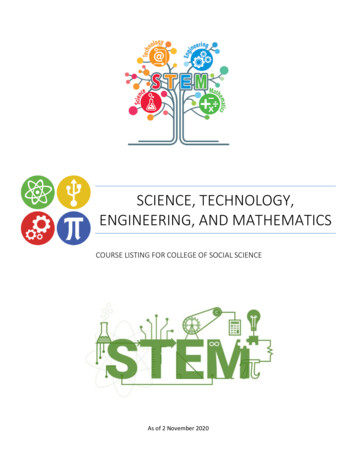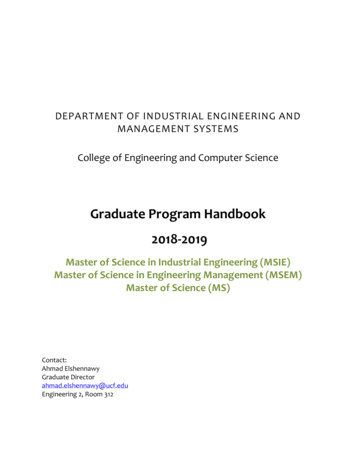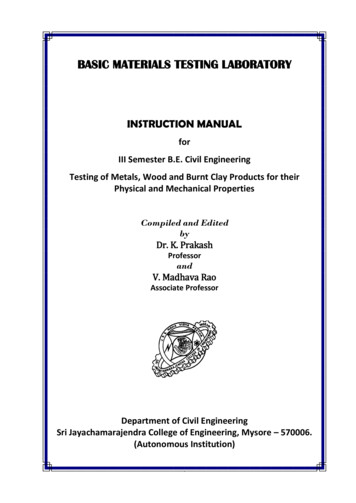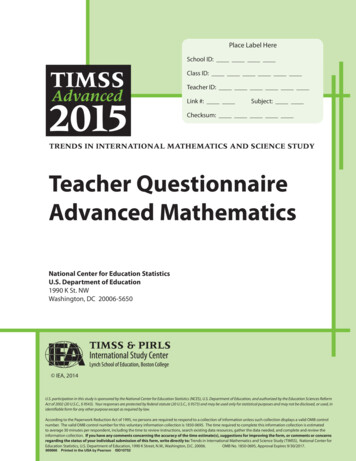
Transcription
SCIENCE, TECHNOLOGY,ENGINEERING, AND MATHEMATICSCOURSE LISTING FOR COLLEGE OF SOCIAL SCIENCEAs of 2 November 2020
1Table of ContentsAnthropology - ANP . 3Animal Science - ANS . 3Human Anatomy - ANTR . 3Astronomy and Astrophysics - AST . 3Biomedical Laboratory Diagnostics - BLD . 4Biochemistry and Molecular Biology - BMB . 5Biomedical Engineering - BME . 6Biological Science - BS . 6Civil Engineering - CE . 7Chemistry - CEM . 8Chemical Engineering - CHE . 10Construction Management Program - CMP . 11Computational Mathematics, Science and Engineering - CMSE . 11Communicative Sciences and Disorders - CSD . 11Computer Science and Engineering - CSE . 12Crop and Soil Sciences - CSS . 13Community Sustainability – CSUS . 13Electrical and Computer Engineering - ECE . 14Engineering - EGR . 16Environmental Engineering - ENE . 16Entomology - ENT . 17Epidemiology - EPI . 17Forestry - FOR . 18Fisheries and Wildlife - FW . 18Geography, Environment, and Spatial Science - GEO . 18Geological Sciences - GLG . 19Human Nutrition and Foods - HNF . 20History - HST . 20Integrative Biology - IBIO . 20Kinesiology - KIN . 23Lyman Briggs - LB . 23Mechanical Engineering - ME . 24Microbiology and Molecular Genetics - MMG. 26Materials Science and Engineering - MSE . 27Mathematics - MTH . 28Neuroscience - NEU . 31Natural Science – NSC. 32Nursing - NUR . 32Pharmacology and Toxicology - PHM . 32Physics - PHY . 32Courses used to meet University requirements cannot be used to meet this requirement.
2Plant Biology - PLB . 34Plant Pathology - PLP . 35Physiology - PSL . 35Psychology - PSY . 36Statistics and Probability - STT . 36MTH 1825, MTH 100E, MTH 103A, MTH 103E, and MTH 290 may not be used for this requirement.NOTE: Some majors have specific STEM courses listed for the degree. Students should consult with the AcademicAdvisors to ensure all degree requirements are completed.Courses used to meet University requirements cannot be used to meet this requirement.
3Anthropology - ANPANP 202Biocultural EvolutionNature and function of culture from hominid origins to present.ANP 203Introduction toArchaeologyTheory, methodology, and techniques of archaeology. Applications to questions about past humanbehavior. History and concepts of archaeology as an anthropological subdiscipline.ANP 206Introduction to Physical Problems, data, and methods of physical anthropology. Human genetics, hominid evolution, primateAnthropologystudies, human osteology, and human diversity.ANP 440Hominid FossilsANP 441Osteology and Forensic Human bone and skeletal biology and analysis. Methods of forensic anthropology. Analysis of skeletalAnthropologyremains, forensic pathology, and forensic archaeology.ANP 443Human AdaptabilityANP 463Laboratory Methods in Preparation and preservation of archaeological data. Conservation, cleaning, cataloguing, andArchaeologyclassification. Analysis of lithics, ceramics, faunal and floral remains, metals, and glass.ANP 464Field Methods inArchaeologyTheories of human evolution during the past five million years fossil evidence.Human adaptation to physical, biological and social environments. Adaptive models from ecology,demography, genetics, physiology, nutrition and medicine. Theoretical and methodological issues in humanadaptation studies across various populations.Field research. Survey, excavation, mapping, data recording, and field laboratory procedures.Animal Science - ANSANS 305Applied AnimalBehaviorTechniques for assessing health and welfare of domestic animals based on their behavior.ANS 415Growth andMusculoskeletalBiologyPrinciples of growth in mammalian and avian species. Regulation of bone, cartilage, connective tissue, fat,and muscle metabolism. Extracellular matrix proteins and their function. Introduction to musculoskeletaldiseases.ANS 427EnvironmentalImpact of environmental chemicals on health and modern society. Cellular and organ functions and theirToxicology and Society interface with the environment. Limitations of scientific investigation and environmental regulations.Human Anatomy - ANTRANTR 211Human Tissues andCells for MedicalIllustratorsElementary structure and function of human tissues, cells, and representative biomolecular classes. Virtualhistology laboratory.ANTR 350Human Gross Anatomy Survey of human systemic gross anatomy with clinical illustrations. Structural basis of organ systemfor Pre-Healthphysiology. Introduction to medical terminology and clinical language.ProfessionalsANTR 355Human Gross Anatomy Introductory, structured laboratory survey of human regional gross anatomy using prosections, medicalLaboratoryimaging, and multimedia for students in allied medical fields. Correct usage and pronunciation of medicalterminology.ANTR 440Human AnatomicVariationHuman anatomical variation including developmental, pathological and accidental.Astronomy and Astrophysics - ASTAST 101The CelestialClockworksRelationship between ancient skylore and timekeeping. Establishment of a calendar and celestialnavigation. Development of the Greek horoscope as a time recorder and coordinate system.AST 207The Science ofAstronomyIn-depth study of one topic in astronomy with emphasis on key discoveries. Topics may be cosmology, thesolar system, and the life of stars.AST 208Planets and Telescopes Origin and nature of the solar system. Planets of the solar system and other star systems. Determinationof time and celestial coordinates. Astronomical instruments and observational methods.Courses used to meet University requirements cannot be used to meet this requirement.
4AST 301Junior ResearchSeminarPreparation and presentation of a review paper on a current topic in astronomy or astrophysics.AST 304StarsPhysical processes that determine the structure and evolution of stars. Observations of stars and starclusters. Spectra of stars.AST 308Galaxies andCosmologyThe Milky Way. Structure and content of galaxies. Active galaxies and quasars. The expanding universe.Modern cosmological models.AST 410Senior ThesisDesign and execute an original experiment or computation. A written and oral report of the research isrequired.Biomedical Laboratory Diagnostics - BLDBLD 204Mechanisms of Disease Pathophysiological mechanisms of diseases. Selected applications to organ system pathology.BLD 213LClinical LaboratoryMethodsBLD 214LBiomedical Laboratory Basic techniques, skills and safety in biomedical research. Ethical conduct of research and regulatoryResearch Techniques principles such as Good Laboratory Practice. Maintaining a research notebook for legal and intellectualproperty purposes. Offered second half of semester.BLD 302Clinical ChemistryCorrelation of common medical laboratory testing and associated disease states, including comprehensivemetabolic panel, lipid panel, thyroid panel, urinalysis and drugs of abuse screening.BLD 313Quality in ClinicalLaboratory PracticeConcepts and principles of clinical laboratory analysis and the statistical evaluation of the data producedas related to quality.BLD 314LAdvanced ClinicalLaboratory MethodsDiagnostics assays across various disciplines within the clinical laboratory including hematology,immunohematology, coagulation, urinalysis, and molecular diagnostics. Data interpretations andBLD 324Hematology andHemostasisPhysiology and biochemistry of normal hematologic and hemostatic systems. Principles of diagnosticassays to detect diseases affecting those systems.BLD 324LIntroductoryLaboratory inHematology,Hemostasis andUrinalysisRoutine laboratory assays used to assess the health of the hematological, hemostatic, and urinarysystems.BLD 365Medical MicrobiologyLaboratory diagnosis, disease and epidemiology of the most common bacterial, viral, fungal and parasiticpathogens and concepts in infectious disease control, prevention and treatment.BLD 365LMedical MicrobiologyLaboratoryPractical experience in safely and accurately performing standard clinical microbiology tests to diagnosedisease-causing microbes.BLD 366Infectious Diseases ofEast AfricaBiology and laboratory diagnosis of the most common infectious disease of the region. Health disparitiesand healthcare system organization.BLD 402Advanced ClinicalChemistryDifferences in clinical laboratory testing results between normal and diseased populations. Metabolic andendocrine systems, acquired and inherited diseases, therapeutic drug monitoring and toxicology.BLD 416Clinical ChemistryCorrelation of laboratory test results with normal physiology and biochemistry and with disease states.Metabolic and endocrine systems. Acquired and inherited diseases. Therapeutic drug monitoring, andtoxicology.BLD 424Advanced Hematology Etiology and pathogenesis of diseases of the hematologic and hemostatic systems including anemias,and Hemostasisleukemias, and hemophilias. Diagnostic testing for such diseases.BLD 424LAdvanced Hematology, Specialized and advanced assays used in the diagnosis of diseases of the hematological, hemostatic, andHemostasis andurinary systems.Urinalysis LaboratoryBLD 430Molecular DiagnosticsConcepts and principles of molecular analysis applied to medical diagnostics and related applications.BLD 430LMolecular DiagnosticsLaboratoryMolecular technologies with emphasis on clinical and diagnostic applications.BLD 434Clinical ImmunologyConcepts of innate and adaptive immunity. Immunodeficiency and autoimmunity. Priniciples andapplications of immunoassays in medical laboratories.BLD 435ImmunohematologyPrinciples and practice of transfusion medicine including blood typing. Offered first ten weeks ofsemester.Lab safety and standards of good laboratory practice including specimen handling and processing.Application of technologies and techniques to the performance of clinical diagnostic testing.Courses used to meet University requirements cannot be used to meet this requirement.
5BLD 435LImmunohematologyLaboratoryMethods of blood typing and pre-transfusion testing.BLD 439Histocompatibility and The theory and principles of histocompatibility and immunogenetics as applied to transplant medicine.ImmunogeneticsBLD 446Immunobiology ofNeoplasiaThe biology of neoplastic cells (cancers, leukemias, lymphomas), the immune response to neoplasias, andimmunotherapy of cancer.BLD 447Immunomodulationand ImmunotherapyCurrent applications of Immunology understanding in the immunomodulation and immunotherapy ofinfectious disease, immunodeficiencies, autoimmune disease, and cancers.BLD 450Eukaryotic PathogensMedically important fungi and parasites. Host-parasite relationships, life cycles, culture, identification,and associated diseases.BLD 452LImmunodiagnosticsLaboratoryPerformance of immunopurifications, in vitro diagnostic assays and basic flow cytometry. Data analysisand quality control evaluation.BLD 460Advanced MolecularDiagnosticsCommon and specialized molecular diagnostic technologies applied to medical diagnostics and relatedapplications.BLD 465Advanced MedicalMicrobiologyAdvanced laboratory diagnosis, epidemiology, and prevention of infectious diseases using an anatomicalsystem specimen approach to study a comprehensive set of human pathogens and microbiota.BLD 465LAdvanced MedicalMicrobiologyLaboratoryPractical experience in safely and accurately performing standard clinical microbiology tests to processclinical specimens, identify pathogens and perform and interpret susceptibility testing.BLD 471LAdvanced ClinicalChemistry LaboratoryApplication and integration of theory and technical skills in clinical chemistry and biochemistry.BLD 472Advanced ClinicalChemistryTheoretical aspects of clinical chemistry, chemical and biochemical reactions, statistical analysis, andpathophysiologic relationships. Integration of cognitive material with clinical laboratory test results.BLD 473LAdvanced ClinicalHematology and BodyFluids LaboratoryApplication and integration of theory and technical skills in hematology, hemostasis, and body fluidanalysis.BLD 474Advanced ClinicalHematology and BodyFluidsTheoretical aspects of advanced hematology, hemostasis and body fluid analysis. Integration of cognitivematerial with clinical laboratory test results.BLD 475LAdvanced ClinicalImmunology andImmunohematologyLaboratoryApplication and integration of theory and technical skills in immunology and immunohematology.BLD 476Advanced ClinicalImmunology andImmunohematologyTheoretical aspects of immunology and immunohematology. Integration of cognitive material with clinicallaboratory test results.BLD 477LAdvanced ClinicalMicrobiologyLaboratoryApplication and integration of theory and technical skills in clinical microbiology and infectious disease.BLD 478Advanced ClinicalMicrobiologyTheoretical aspects of clinical microbiology and infectious disease. Integration of cognitive material withclinical laboratory test results.Biochemistry and Molecular Biology - BMBBMB 161Cell and MolecularBiologyMacromolecular synthesis. Energy metabolism. Molecular aspects of development. Molecular genetics.BMB 171Cell and MolecularBiology LaboratoryPrinciples and applications of common techniques used in cell and molecular biology.BMB 181HHonors Cell andMolecular BiologyPhysicochemical and molecular organization of cells as the unifying framework for genetics, evolution,and the social relevance of biology.BMB 191HHonors Cell andMolecular BiologyLaboratoryBasic techniques of cellular and molecular biology including experimental design and hypothesisformulation; biochemistry, molecular biology and genetics.Courses used to meet University requirements cannot be used to meet this requirement.
6BMB 200Introduction toBiochemistryIntroductions to the major classes of biomolecules and the metabolism of these molecules.BMB 400Introduction toBioinformaticsManaging and analyzing biological data with bioinformatic tools, basic programming, and statistics.BMB 401ComprehensiveBiochemistryStructure and function of major biomolecules, organization and regulation of metabolic pathways. Specialemphasis on eukaryotic systems and the biochemical basis of human disease.BMB 461Advanced Biochemistry I Structure, function, and biophysical properties of biomolecules in a wide variety of organisms. Emphasison proteins and carbohydrates including enzyme catalysis and kinetics, the central metabolic pathways,and photosynthesis.BMB 462Advanced Biochemistry Continuation of BMB 461. Structure, function, and biophysical properties of lipids and nucleic acidsIIincluding membranes, lipid metabolism, signaling and metabolic regulation, DNA replication and repair,transcription, translation, and regulation of gene expression.BMB 471Advanced Biochemistry Biochemical methods and principles used in the study of enzymes (proteins), carbohydrates, lipids, andLaboratorycell organelles.BMB 472Advanced MolecularBiology LaboratoryMethods of molecular biology and the underlying principles on which these methods are based.BMB 490Biochemistry ResearchParticipation in laboratory research projects.BMB 495Undergraduate Seminar Extension and synthesis of concepts of biochemistry. Relationships to societal issues.(W)BMB 499Senior Thesis (W)Laboratory research culminating in a thesis.Biomedical Engineering - BMEBME 425Biomaterials andBiocompatibilityMaterials science of human implants. Design requirements imposed by the human body, and need forbodily protection.BME 444Biosensors for Medical Biosensors, their components, properties, and associated electronics for applications in medicalDiagnosticsdiagnostics.BME 494Biofluid Mechanics and Applications of fluid mechanics, heat transfer, and thermodynamics to biological processes, including bloodHeat Transferflow in the circulatory system, heart function, effects of heating and cooling on cells, tissues, and proteins.Pharmacokinetics.BME 495Tissue MechanicsApplication of solid mechanics to understanding mechanical responses of biological tissues. Microstructureand biological function for soft and hard connective tissues and muscle.BME 497Biomechanical Designin ProductDevelopmentBiomechanical product design with application to people or animals. Synthesis, prototyping, and analysis ofdesigns. Project management. Market research.Biological Science - BSBS 161Cell and MolecularBiologyMacromolecular synthesis. Energy metabolism. Molecular aspects of development. Molecular genetics.BS 162Organismal andPopulation BiologyBiological diversity and organismal biology. Principles of evolution, transmission genetics, populationbiology, community structure, ecology.BS 171Cell and MolecularBiology LaboratoryPrinciples and applications of common techniques used in cell and molecular biology.BS 172Organismal andPopulation BiologyLaboratoryNature and process of organismal biology including experimental design, statistical methods, hypothesistesting in genetics, ecology, and evolution.BS 181HHonors Cell andMolecular BiologyPhysicochemical and molecular organization of cells as the unifying framework for genetics, evolution, andthe social relevance of biology.BS 182HHonors Organismal and Diversity and basic properties of organisms, with emphasis on genetic principles, ecological interactions,Population Biologyand the evolutionary process. Historical approach to knowledge discovery.Courses used to meet University requirements cannot be used to meet this requirement.
7BS 191HHonors Cell andMolecular BiologyLaboratoryBasic techniques of cellular and molecular biology including experimental design and hypothesisformulation; biochemistry, molecular biology and genetics.BS 192HHonors Organismal and Nature and process of organismal biology, including experimental design and statistical methods,Population Biologyhypothesis testing, genetics, ecology, and evolution.LaboratoryCivil Engineering - CECE 221StaticsVector description of forces and moments. Two- and three- dimensional equilibrium of particles and rigidbodies. Analysis of trusses, frames, and machines. Coulomb friction.CE 273Civil and Environmental Measurements, surveying and error analysis with applications to civil and environmental engineeringEngineeringproblemsMeasurementsCE 274Graphics for Civil andEnvironmentalEngineersBasic operations in CAD software with applications in civil and environmental engineeringCE 280Principles ofEnvironmentalEngineering andSciencePhysical, chemical and biological processes related to environmental science and engineering.Environmental systems analysis with application to air, water and soil. Analysis of environmental problemsand development of engineering solutions.CE 305Introduction toStructural AnalysisTheory of structural analysis for statically determinate structures. Qualitative structural analysis andbehavior. Load estimation and placement. Introduction to structural analysis computer software.Introduction to statically indeterminate structures.CE 312Soil MechanicsEngineering properties of soil and their measurement. Effective-stress concept. Permeability and seepage.Compaction. Consolidation, shear strength, and stress-strain behavior.CE 321Introduction to FluidMechanicsFluid properties, fluid statics, fluids in motion. Conservation of mass, energy, and momentum. Dimensionalanalysis and similitude. Internal and external flows. Applications.CE 337Civil EngineeringMaterialsCommon civil engineering construction and paving materials: aggregates, inorganic cements, asphalts,concretes, wood, and steel. Composition, structure, physical and mechanical properties, tests, andproduction mix design.CE 341TransportationEngineeringOverview of transportation system issues and problems. Fundamentals of highway design and operations.Planning and evaluation of transportation system alternatives.CE 371Sustainable Civil andEnvironmentalEngineering SystemsPrinciples and tools of sustainable design and engineering economics in Civil and EnvironmentalEngineering.CE 372Risk Analysis in Civiland EnvironmentalEngineeringApplications of probability, statistics, uncertainty and risk analysis to topics in civil and environmentalengineering, characterization of system safety, and comparison tests for engineering quality control andenvironmental analyses.CE 400Structural MechanicsMatrix methods of structural analysis. Flexibility method. Direct stiffness method for plane structures.Elastic supports, inclined supports, member releases and non-prismatic members. Application software.CE 405Design of SteelStructuresDesign of steel beams, columns, tension members and connections. Stability and plastic strength.CE 406Design of ConcreteStructuresDesign of reinforced concrete beams, slabs, columns and footings.CE 407Materials Engineering: General families of materials, materials design process for civil and environmental engineering problems,Properties, Selectionstructural materials properties, processing methods and environment, microstructure of materials,and Processingstructural materials selection by utilizing bubble charts.CE 418GeotechnicalEngineeringCE 421Engineering Hydrology Hydrologic design of storm water systems. Equilibrium hydrograph analysis, unit hydrographs, infiltration,hydrograph synthesis, and reservoir routing. Groundwater: Darcy's law, flow nets, well hydraulics, designof capture wells.Shallow foundation design: bearing capacity, stress distribution, and settlement analysis. Pile foundations.Design of retaining structures, including rigid walls, braced excavations, and sheet-pile walls. Stability ofslopes and embankments.Courses used to meet University requirements cannot be used to meet this requirement.
8CE 422Applied HydraulicsFundamentals of open-channel flow. Rapidly and gradually varied nonuniform flow analy
Application of technologies and techniques to the performance of clinical diagnostic testing. BLD 214L Biomedical Laboratory Research Techniques Basic techniques, skills and safety in biomedical research. Ethical conduct of research and regulatory principles such as Good Laboratory Pr











